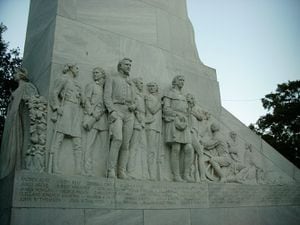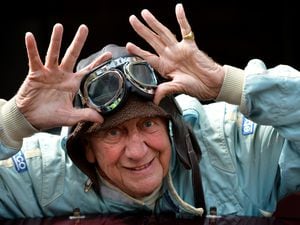Revealed: Shropshire man's role in historic battle features in new book
A Shropshire man's part in one of the most historic battles in the history of the United States is marked in a new book.

James C Gwynne fought and died alongside American heroes Colonels William Travis, James Bowie and Davy Crockett at the battle of the Alamo in 1836.
The battle has been made the subject of Hollywood films and now prolific author and historian James Bancroft has penned Alamo Defenders: A Fresh Perspective on the Heroes of 1836.
Mr Bancroft says it is the first book specifically about the siege and battle ever to be published by a British writer.

James C Gwynne, who was 32 when he died at the Alamo, was born in Shropshire. He was baptised on August 1 1802, at St Leonard’s Church in Bridgnorth, the son of Charles and Hannah Gwynne. He went to America in the early 1830s.
The Alamo was a key battle between people demanding the independence of Texas from Mexico. Texas went on to become a part of the United States of America.

Mr Bancroft says: "As the early light of dawn on March 6 1836 illuminated the sky across the Alamo at San Antonio in Texas, a 32-year old Shropshire Lad named James Gwynne was disturbed from his sleep to be informed that the enemy in large numbers were advancing to assault their makeshift fort.
"Stirred into action, he picked up his musket and as he ran across the compound his commanding officer shouted ‘Come on, boys! The Mexicans are upon us and we’ll give them Hell!’
"He took his place at a cannon at the rampart, which the highly experienced Mexican army were assaulting most vigorously.

"He was one of as many as 30 British-born men who died at the Alamo, and most of the others had British ancestry, including the commanding officer, William Barret Travis."
In 1836 Texas fought for independence from Mexico, and on hearing that the notorious Mexican leader, Generalissimo Santa Anna, was on his way to San Antonio with a large army, James Gwynn joined Captain Carey’s Artillery Company.
Along with Travis, Bowie and Crockett, and about another 180 men, Private Gwynne chose to defend a former mission complex known as The Alamo (Cottonwood in English), which they had turned into a kind of fort.
Mr Bancroft said: "The attack happened after a siege which lasted nearly two weeks, during which time the defenders, who were mostly volunteers with no real experience of warfare, had suffered the stress and anguish caused by the noise and danger of continuous cannon bombardments and sniper fire, suffering in arid conditions that sapped strength and the will to resist, and with very little sustenance.
"It was gruelling to the extreme. It was during the siege that Colonel Travis is said to have called all his men together and broke the dreadful news that no help was coming and defeat was only a matter of time.
"He drew a line in the dirt with his sword and asked that those who were with him to cross it – Private Gwynne, and all but one of them did."
After the savage fury of a fierce hand-to-hand battle all the defenders capable of bearing arms were killed and their bodies were unceremoniously burned.
Texas became a republic after Santa Anna and the Mexican army was finally defeated at the decisive battle of San Jacinto, on April 21, 1836, when the Texans charged into battle shouting: ‘Remember the Alamo!’ Texas became part of the United States of America a decade later.
The front of the Alamo chapel has been preserved in San Antonio as a memorial to James Gwynne and all the other defenders, and his name appears on the ‘Spirit of Sacrifice’ memorial which stands adjacent to the Alamo complex.
There is no memorial anywhere in Britain dedicated to any of the British-born men who took part in the siege and battle of the Alamo.
Although the British rock star and Alamo enthusiast Phil Collins has produced a book containing information about his collection of artefacts, which he has donated to the Alamo, Mr Bancroft's book is the first book specifically about the siege and battle ever to be published by a British writer.
Mr Bancroft was born at Salford, Greater Manchester in 1953 where he still lives.
He has produced more than 100 books and articles, the subjects of which reflect his varied interests.
He has contributed a number of articles for The New Oxford Dictionary of National Biography, and his book Rorke’s Drift: The Zulu War, 1879 has been re-printed seven times.
His JWB Historical Archive, compiled over five decades, is one of the largest private collections of its kind in the world. When he is not writing, he enjoys singing and playing and listening to music, and being with his growing family.
His publishers Pen and Sword Books are in Barnsley, and the book is also available on Amazon.





